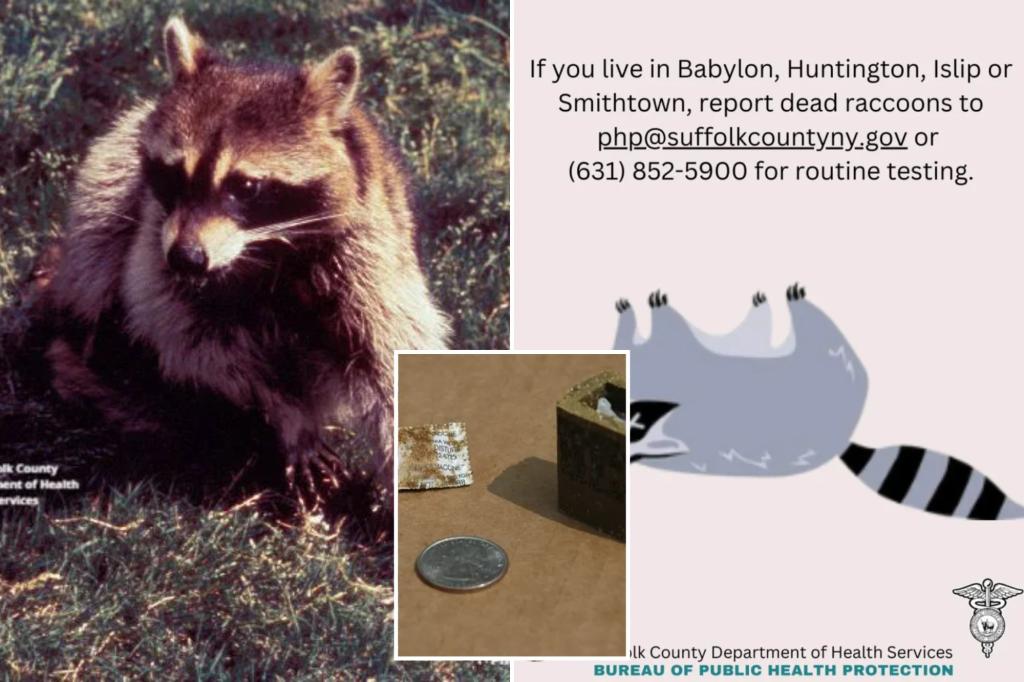Rising Concerns: Health Officials Sound Alarm Over Rabid Raccoons in Long Island
Long Island residents are facing a mounting public health crisis as five rabid raccoons have been identified across the region in recent weeks. Local health officials issued urgent warnings this week, urging the public to avoid contact with wildlife and ensure pets are vaccinated. The cases, concentrated in Nassau and Suffolk counties, mark a troubling spike in rabies infections, prompting increased surveillance and community outreach.
Rabies Outbreak Reaches Critical Levels
The Suffolk County Health Department confirmed three new cases in the past seven days alone, bringing the 2024 total to five—a 150% increase compared to this time last year. Raccoons account for nearly 80% of rabies cases in New York state, according to the Department of Health. The infected animals exhibited telltale signs: disorientation, aggression, and foaming at the mouth.
“This is the most significant rabies cluster we’ve seen in a decade,” said Dr. Emily Chen, Suffolk County’s Public Health Veterinarian. “Rabies is nearly always fatal once symptoms appear, so prevention is absolutely critical. We’re working with animal control to expand trapping efforts in hotspot areas.”
How Residents Can Protect Themselves
Health authorities recommend these immediate precautions:
- Vaccinate all pets and livestock (required by New York law for dogs, cats, and ferrets)
- Avoid feeding or approaching wild animals, especially nocturnal creatures active during daylight
- Secure trash cans with locking lids to deter raccoon activity
- Report erratic animal behavior to local animal control (see contact list below)
Recent incidents include a rabid raccoon attacking a leashed dog in Smithtown and another entering a garage in Huntington Station. “Our officers responded to 32 potential exposure calls last weekend,” noted Robert Hayes, Director of Nassau County Animal Control. “Thankfully, no human exposures were confirmed, but we’re seeing unprecedented activity.”
The Science Behind the Spread
Rabies virus spreads through saliva, typically via bites. The CDC reports only 1-3 human cases annually nationwide, but post-exposure treatments exceed 55,000 yearly. New York’s rabies map shows particular concern along the “raccoon rabies belt” stretching from Maine to Alabama.
Wildlife biologist Dr. Aaron Jacobs explains: “Urbanization forces wildlife into closer contact with humans. Raccoons adapt remarkably well to suburban environments, and their population density directly correlates with transmission rates.” A 2023 Cornell University study found Long Island’s raccoon population has grown 17% since 2019.
What to Do After Potential Exposure
If bitten or scratched:
- Immediately wash wounds with soap and water for 15 minutes
- Contact your healthcare provider or emergency services
- If possible, safely contain the animal for testing (without risking further contact)
Post-exposure prophylaxis (PEP) involves four vaccine doses over two weeks. The treatment is 100% effective when administered promptly. Suffolk County offers free rabies clinics monthly, with the next event scheduled for March 15 at the H. Lee Dennison Building.
Community Response and Next Steps
Local schools have incorporated rabies awareness into science curricula, while neighborhood apps like Nextdoor report surging posts about wildlife sightings. Some residents advocate for more aggressive measures. “We need county-wide bait vaccination programs like they use upstate,” argued Jamesville homeowner Mark Reynolds, whose trash cans were overturned by a suspected rabid raccoon last Tuesday.
Officials emphasize cooperation: “Public vigilance is our first line of defense,” said Chen. “By reporting unusual animal behavior and maintaining vaccinations, we can contain this outbreak.” Surveillance will continue through spring, traditionally peak mating season when rabies spreads fastest.
For immediate concerns: Contact Suffolk County Vector Control at (631) 852-4270 or Nassau County Animal Control at (516) 571-8743 after hours. Stay updated through the NYS Department of Health rabies tracking portal.
See more WebMD Network



